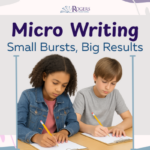When I first read Understanding By Design, I wasn’t completely sold.
I understood the path the authors outlined, it all made sense. It just seemed really overwhelming for me as a teacher. Almost impossible, in fact, with all the pressures and expectations that come with leading a classroom.
All of my feels are still fresh as I now, in my roles as principal and professional developer, nudge my teachers towards embracing backward design for themselves!
While proven effective, backward design takes time – and we know teachers are fresh out of that, sound content knowledge, and it forces educators to consider open-ended questions about their instruction. So I know the stress it creates, but I also know the power it yields!
This summer, I reflected on the many comments and conversations I had with my teachers last year. I am fortunate that all of my teachers are strong, knowledgable, and reflective teachers, so having open conversations about instruction is commonplace.
The trend I noticed from reviewing my conversations was there were too many activities that had questionable connections to the learning objective. Another trend was not really knowing what the end learning goal was. Sure, lessons were on topic, important conversations were had, and complex assignments were handed out, but there was no way to know if goals were met because goals had not been set.

So, this year, we will focus on Backward Design. While it is so much more complex than what I am sharing (please refer to the book for a more in-depth explanation), I will share an overview.
- Identify what students should know and be able to do at the end of the unit.
- Think about the big understandings or transferrable skills. Yes, you might be teaching “The American Revolution”, but what do you want the students to know and be able to do afterward? Maybe its the idea that ‘Leadership can play a significant role in the outcome of war’ as your enduring idea.
- Then you must consider what you want students to know and be able to do. The key here is not to overwhelm the students forcing them to know too much! I won’t give a number of things they should know, but perhaps it looks something like this:
- Students will know: the role certain individuals played in the influence and outcomes of the events of the American Revolution (name them). You can then choose a few other items students should know, if you like.
- Students will be able to: evaluate how leadership influenced the political development of the early nation.
- Decide how to assess the desired learning.
- Now, each teacher will need to decide how to prove if the students are able to evaluate how leadership influenced the political development of the early nation. This is no easy feat. They cannot simply go to Google, give a state-released assessment, or create a multiple-choice test. The test needs to prove students can do what you expected. In this case, students might need to give a presentation, write an essay, or create a complex graphic to really communicate understanding.
- Plan learning experiences.
- Now that you know what you want your students to know, understand, and be able to do, AND you know how they will be assessed, this is when you can plan lessons.
- Each lesson should target the learning goals and help prepare students for success in tackling the assessment.

I am fully aware that planning this way is much more time-consuming and forces so much more planning on the front end. I am also very aware that time, or a lack thereof, is typically the leading cause of stress in education.
So, instead, don’t think of it as time-consuming. Think of this backward design planning process as an investment. Spending the time up front to make each learning experience impactful will pay off with great dividends as you see your students become more engaged, focused, and successful learners!





